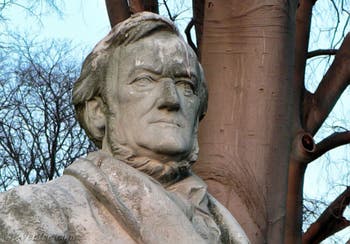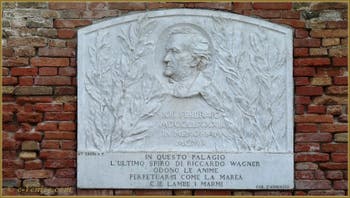Richard Wagner in Venice

Portrait of Richard Wagner Richard Wagner was born in Leipzig, Germany in 1813.
After studying literature and philosophy, he entered the Leipzig School of Music, the Thomasschule and composed his first opera, The Fairies, at the age of 20.
A Wandering Life
Richard Wagner's life was marked by wandering.After serving as choirmaster in Würtzburg and conductor in Magdeburg and Königsberg, he obtained the post of conductor in Riga in 1837.
Tannhäuser, Lohengrin
In 1839, he sailed for London.There, he was caught in a violent storm that inspired The Flying Dutchman, an opera he completed in 1841.
Then, he returned to Germany, to be Kapellmeister at The Court of Dresden for 7 years.
This was a decisive period for his musical research (Tannhäuser, Lohengrin) and for the development of his theories between art and revolution.
The Tetralogy, the Niebelunger Ring, the Rhine Opera, the Valkyrie...
In 1852, he composed La Tétralogie, l'Anneau de Niebelungen, then l'Opéra du Rhin, the Walkyrie and part of Siegfried, which would remain on hold for 10 years.Between 1853 and 1858, he travelled frequently, to escape financial problems, among other things.
At Zurich, Otto Wesendonck gave him hospitality.
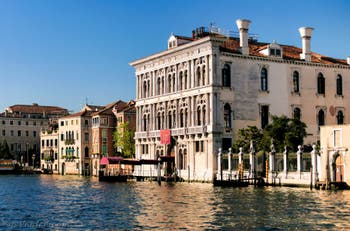
The Palazzo Vendramin Calergi But Wagner falls in love with Mathilde, the wife of Otto.
And here was Wagner, fleeing Switzerland after an argument more violent than most with his wife Minna, who obviously didn't appreciate it at all.
Towards Venice
Following the advice of his friend Karl Ritter he chose to settle in Venice.He would stay at the Hotel Danieli.
Wagner then wrote:
“on 29 August 1858 I arrived in Venice.
During the journey from the Grand Canal to the Piazzetta, an impression of great melancholy: grandeur, beauty and decadence, all adjacent to each other.
I was delighted, however, to think that here there was no modern prosperity, hence no turbulent triviality.
St. Mark's Square made a magical impression on me.
A distant world, a living era. This impression fully satisfied my desire for solitude.
Nothing here gives the sensation of real life: everything acts objectively, like a work of art.
I want to stay here - and this will be fulfilled.”
Richard Wagner
Richard Wagner performs Tristant and Isolde in Venice
On 30 August, Wagner took up residence at the Palazzo Giustiniani Bernardo.
Richard Wagner: Autograph of Tristan and Isolde He brings from Zurich his piano Erard and his bed.
He wanted to complete Tristan and Isolde in the greatest solitude.
The only person who could visit him is Prince Piotr Vladimirovitch Golgorouki, with whom he will often play with whom he often played 4-handed piano.
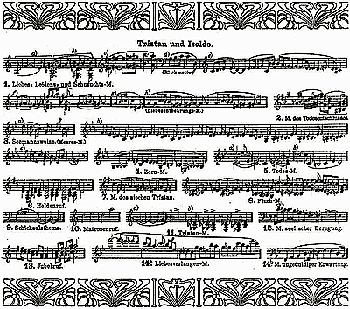
Richard Wagner, the Libretto of Trisan and Isolde
The Song of the Gondoliers...
It was there, during a sleepless night, that he heard the song of the gondoliers which inspired the melancholy melody of the shepherd, the unforgettable phrase from Act 3 of Tristan and Isolde.Restaurants and Cafés
Wagner often dined at the Albergo San Marco where a table was constantly reserved for him.He was a regular visitor to the café Lavena, which was a favourite meeting place for musicians and intellectuals.
Richard Wagner: Revolutionary Activist
At the time, Venice was under Austrian rule and teeming with spies keeping an eye on foreigners.Wagner was considered a revolutionary activist by the kingdom of Saxony, the Venetian commissioner Angelo Crespi did his utmost to avoid his extradition by drafting soothing reports.
However, Wagner had to leave Venice in March 1859.
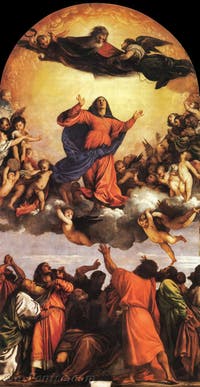
Assumption of the Virgin
Venice: An Enchanted Dream
He writes to Mathilde Wesendonck.“And Venice already seems to me like an enchanted dream. You will one day hear a dream I set to music there.”
Richard Wagner
On 7 November 1861, Richard Wagner returned to Venice.
Titian inspires “The Master Singers”
At the Hotel Danieli, he meets up with Mathilde and her husband Otto.With them, he visited the churches and the painting collections.
Seeing the Titian's Assumption of the Virgin would come as a shock to him.
In “My life” he writes:
“I decided to compose Les Maîtres chanteurs.”
Richard Wagner
This meeting led to the creation of a work of jubilant virtuosity, revealing another Wagner. He then set off again, to Vienna.
Louis II of Bavaria, Bayreuth and Italy again
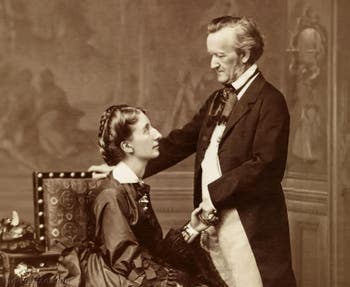
Richard Wagner and his sister Cosima In 1864, he met Louis II of Bavaria, his more than generous patron, who solved his eternal financial problems and enabled him to found the Bayreuth Festival in 1876.
But the complicated relationship between Wagner and Louis II deteriorated and Wagner returned to Italy.
Here he is in Naples, accompanied by Cosima (who is the daughter of Franz Liszt and Marie d'Agoult). Cosima left her husband, the conductor Hans Von Bülow, to marry Richard Wagner and follow him on his wanderings.
Very old and sick, he was withdrawn into himself and became obsessed with organising of his cult celebrated in Bayreuth.
The philosopher Frédéric Nietszche would be highly critical of this.
Richard Wagner dies in Venice at the Palazzo Vendramin Calergi
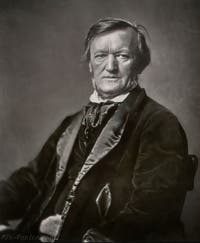
Portrait of Richard Wagner Richard Wagner returned to Venice where he stayed at the Hotel Danieli for three nights on 4 October 1880.
in Venice in spring 1882, Richard and Cosima Wagner visited the Palazzo Vendramin Calergi inhabited by Adolfo Lucchesi Palli, Duke della Grazia, as well as his nephew Henri de Bourbon and his wife Aldegonde de Bragance, Princess of Portugal.
After a few trips, they settled in this palace, for which they had reserved the mezzanine, which alone had around fifteen rooms.
They had a number of servants, including a gondolier: Luigi Trevisan.
Unfortunately, Richard Wagner's health deteriorated to such an extent that he could no longer enjoy anything: neither the artistic pleasures offered by Venice, nor the pleasures of life in society.
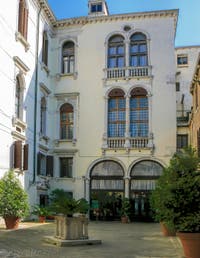
Palazzo Vendramin Calergi At the end of November 1882, the arrival of Franz Liszt was the occasion for a series of social events and concerts given in the grand salon.
Richard Wagner emerged exhausted.
13 February 1883: The End of Richard Wagner, the beginning of the Legend
On February 13, 1883, a final heart attack struck him down for good.His faithful gondolier, Luigi Trevisan, took his remains by gondola to the Santa Lucia station. An overnight train journey brought her back to Bayreuth.
Gabriele d'Annunzio, who was 20 at the time, writes at the end of his novel entitled “The Fire”:
“ - Ah Stelio, I've been waiting for you!
his friend's breathless voice shouted at him in the gust of sound. Richard Wagner is dead!
Bust of Richard Wagner The world seemed diminished in value. [...]
Stelio asked Richard Wagner's widow that the two young Italians who, one evening in November, had carried the fainting hero from the boat to the shore, and four of their companions with them, be allowed the honour of carrying the coffin from the death chamber to the boat and from the boat to the carriage. This honour was granted to them. [...]
The corpse was there, enclosed in the crystal coffin, and beside it, standing, was the woman with the face of snow.
The second polished metal coffin, wide open, shone on the floor, [...]
All eyes were fixed on the chosen one of Life and Death.
An infinite smile lit up the face of the hero lying in the beer: infinite and distant like the glow of glaciers, like the swell of the seas, like the halo of the stars.
Memorial plaque to Richard Wagner The eyes could not bear it; but the hearts, with a wonder and awe that made them religious, believed they were receiving from him the revelation of a divine secret.
[The convoy was short.
The funeral barge went ahead; then came the widow with her loved ones; then came the youthful group.
Above the great path of water and stone, the sky was cluttered with clouds.
The deep silence was worthy of him who, for the religion of men, had transformed the forces of the Universe into an infinite song.”
Gabriele d'Annunzio
In 1910, a plaque adorned with a medallion sculpted by Guido Cadomien, on which is written this text written by Gabriele d'Annunzio was affixed:
IN QUESTO PALAGIO
L'ULTIMO SPIRO DI RICCARDO WAGNER
ODONO LE ANIME
PERPETUARSI COME LA MAREA
CHE LAMBE I MARMI.
Gabriele d'Annunzio
You'll find this plaque on the surrounding wall of the Palazzo Vendramin Calergi overlooking the Grand Canal in Venice.
Tours of the Wagner Rooms at Palazzo Vendramin Calergi
Guided Tours of Wagner's ApartmentsBack to Top of Page


